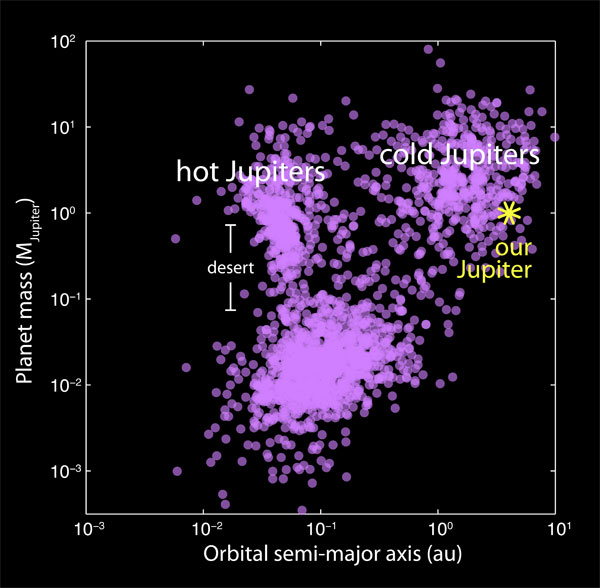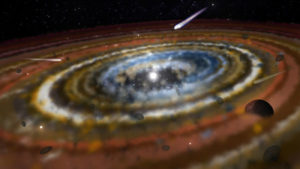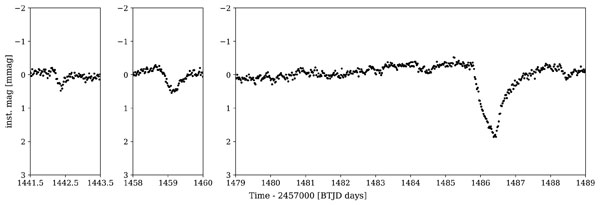Two teams of astronomers have announced the discovery of a Neptune-size planet in an unexpected orbit and three exocomets whizzing around nearby star Beta Pictoris.
Planet Found Transiting the “Hot Neptune Desert”

Emily Bailey
Astronomers examining data from the Next Generation Transit Survey (NGTS) have discovered a planet where it shouldn’t be. At about three times the size of Earth and 20 times Earth’s mass, this sub-Neptune zips around its star every 1.33 days — a proximity that keeps its temperature at a searing 1,200K (1,000°C). Based on its mass and average density, the planet probably has a rocky core and a gaseous envelope.
Dubbed NGTS-4b, this planet is the first to be discovered in the so-called “Neptunian desert” (sometimes also called the sub-Saturn desert”). In contrast to the plethora of hot Jupiters found orbiting close to their host stars, exoplanet surveys have turned up a dearth of hot Neptunes.
Theorists can explain the absence of close-in Neptunes if giant planets — even close-in ones — form right where they are, rather than forming farther out and then migrating inward. Planets forming in situ would need a certain heft to survive so close to their host star. Irradiation would whip away the gaseous atmospheres of a smaller, Neptune-size planet; only its remaining rocky core would remain.
If in situ formation is the rule, then migration is the exception — but that’s not to say the exception never happens. Richard West (University of Warick, UK) and colleagues propose in the Monthly Notices of the Royal Astronomical Society that this sub-Neptune migrated to its current orbit relatively recently — less than a million years ago. The move would have happened after the star’s more active youth, giving the planet a better chance of holding on to its atmosphere.
Exocomets Detected Around Beta Pictoris

Michaela Pink
Astronomers have discovered three exocomets transiting the nearby star Beta Pictoris, confirming observations taken over the previous three decades.
At only 20-some million years old, Beta Pic is in the “young adult” phase of starhood, still surrounded by a disk of dust and gas in which planets are forming. One of these, the young gas giant Beta Pictoris b, was directly imaged in 2008 by the Very Large Telescope in Chile.
Now, using data on the star’s brightness from the Transiting Exoplanet Survey Satellite (TESS), Sebastian Zieba (University of Innsbruck, Austria) and colleagues have traced out a 105-day-long light curve, revealing three distinctive dips indicating the passage of exocomets. The dips are asymmetric, not periodic, and the longest one lasts about two days.

Sebastian Zieba / Konstanze Zwintz
“What we are seeing is not the comet nucleus itself, but the material blown off the comet and trailing behind it,” explains coauthor Konstanze Zwintz (also at the University of Innsbruck). That material then blocks the star’s light, producing the dip in brightness. However, the TESS data cannot distinguish big, fluffy exocomets from small, dense ones. To better characterize these exocomets, the team suggests monitoring for future transits while taking simultaneous spectroscopic observations.
Exocomets around Beta Pictoris had long been suspected, since 1987 observations detected changing chemical fingerprints around the star. Likewise, exocomets have been proposed to explain observations of three other stars monitored by the Kepler mission, including the infamous Boyajian’s Star. However, while Kepler was mostly gazing at older and more distant stars, astronomers expect TESS to catch many more exocomet-rich systems as it surveys the nearest 200,000 stars.
The paper, which will appear in Astronomy & Astrophysics, can be found as a preprint on the astro-ph arXiv.
 4
4









Comments
Anthony Barreiro
May 30, 2019 at 9:57 pm
Infamous? Well known for some bad quality or deed; wicked, abominable? The star is innocent of any wrongdoing, and not responsible for anyone's unreasonable interpretation of its light curve.
You must be logged in to post a comment.
ngc4565
June 1, 2019 at 5:11 am
As in that other well used and idiotic phrase. Planets or stars lurking. How do astronomical objects lurk??
You must be logged in to post a comment.
Anthony Barreiro
June 3, 2019 at 4:27 pm
I don't think Dr. Young has ever described a planet as lurking.
But watch out for Nibiru! 😉
You must be logged in to post a comment.
Bob
June 2, 2019 at 10:19 am
Thanks for this update on an exoplanet and three exocomets.
You must be logged in to post a comment.
You must be logged in to post a comment.